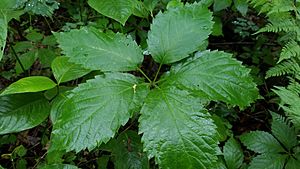Parthenocissus inserta facts for kids
Quick facts for kids Parthenocissus inserta |
|
|---|---|
 |
|
| Scientific classification | |
| Genus: |
Parthenocissus
|
| Species: |
inserta
|
| Synonyms | |
|
|
Parthenocissus inserta (syn. Parthenocissus vitacea), also known as thicket creeper, false Virginia creeper, woodbine, or grape woodbine, is a woody vine native to North America, in southeastern Canada (west to southern Manitoba) and a large area of the United States, from Maine west to Montana and south to New Jersey and Missouri in the east, and Texas to Arizona in the west. It is present in California, but it may be an introduced species that far west.
Contents
Description
Parthenocissus inserta is a climbing and sprawling woody vine (liana), reaching lengths of 20 m, using small branched tendrils with twining tips. The leaves are palmately compound, composed of five leaflets, each leaflet reaching 13 cm in length and 7 cm broad. The leaflets have a coarsely toothed margin.
The flowers are small and greenish, produced in clusters in late spring, and mature in late summer or early fall into small blue-black berries. These berries contain oxalates and the plant may cause dermatitis.
Parthenocissus inserta is closely related to and commonly confused with Parthenocissus quinquefolia (Virginia creeper). They differ in their means of climbing, with the tendrils twining around plant stems in P. inserta lacking the round, adhesive discs found on the tendril tips of P. quinquefolia, though the ends may be club-shaped when inserted into a crevice. One consequence of this is that (unlike P. quinquefolia) it cannot climb smooth walls, only through shrubs and trees. In addition, the leaflets of P. inserta are shiny when young and only slightly pale below, while those of P. quinquefolia are dull above and pale green, whitened, or glaucous below. P. inserta flowerhead branching is dichotomous or trichotomous, with branches of equal thickness, while P. quinquefolia branches unequally, with a definite central axis. The berries of P. inserta are larger, at 8–12 mm in diameter, versus 5–8 mm broad in P. quinquefolia. The petiolules of mature P. inserta leaflets are typically longer, at 5–30 mm long, versus sessile or up to 10 mm in P. quinquefolia.
Taxonomy
Parthenocissus inserta was first described in 1887 by Anton Kerner, as Vitis inserta. It was transferred to Parthenocissus by Karl Fritsch in 1922. Separately, in 1893, Ellsworth Brownell Knerr described it as the variety vitacea of Ampelopsis quinquefolia (a synonym of Parthenocissus quinquefolia). Albert Spear Hitchcock raised the variety to the full species Parthenocissus vitacea in 1894. Kerner's epithet inserta has priority over Knerr's vitacea, so the correct name is Parthenocissus inserta.
Ecology
The flowers of thicket creeper are frequently visited by Mordella marginata, a tumbling flower beetle. Several bee species have been observed collecting pollen from the flowers, including the sweat bees Augochlora pura, Lasioglossum subviridatum, and Lasioglossum zephyrus. The fruits are eaten by birds.
See also
 In Spanish: Parthenocissus inserta para niños
In Spanish: Parthenocissus inserta para niños



